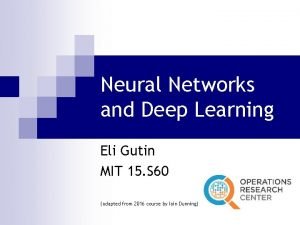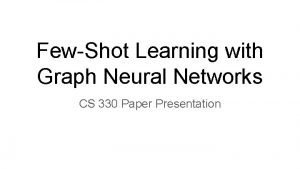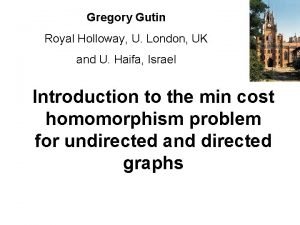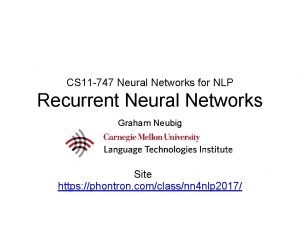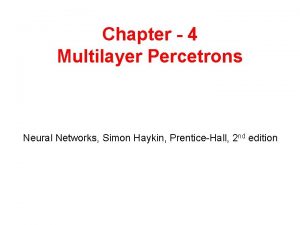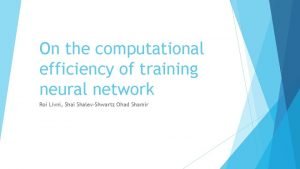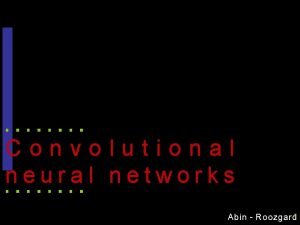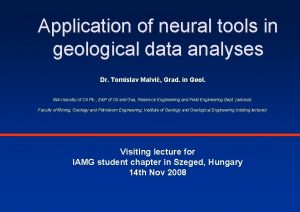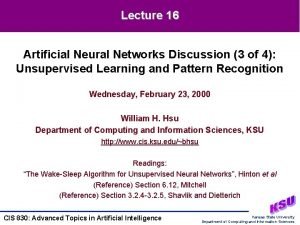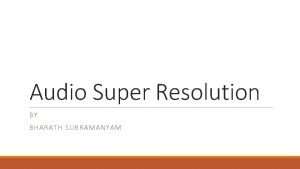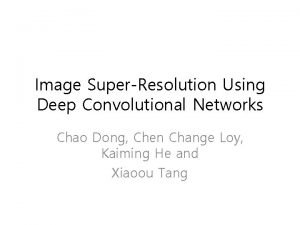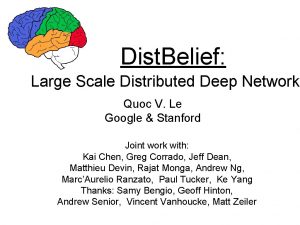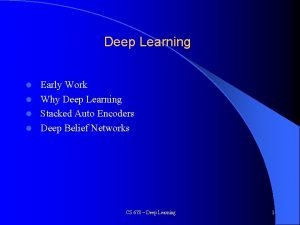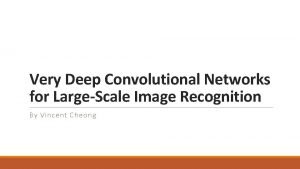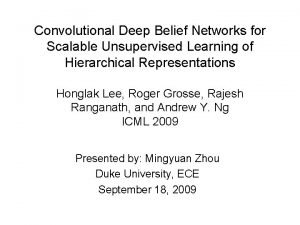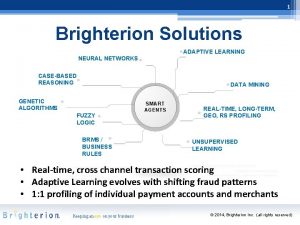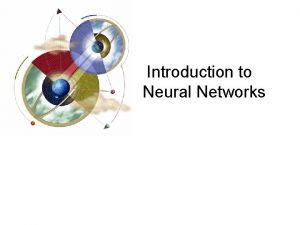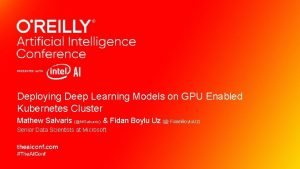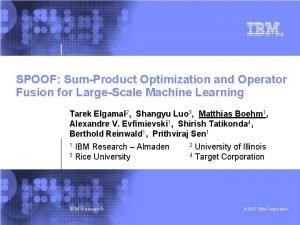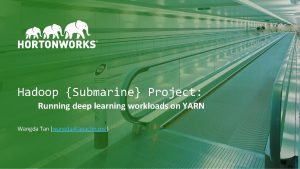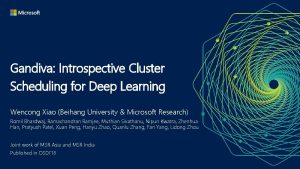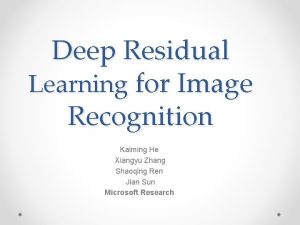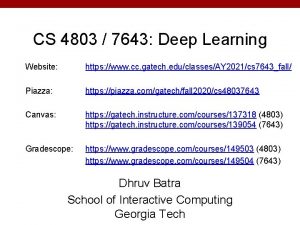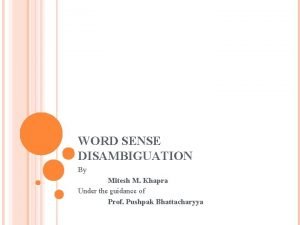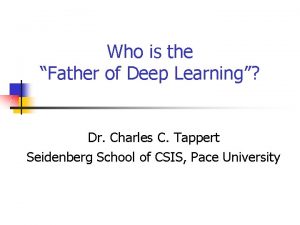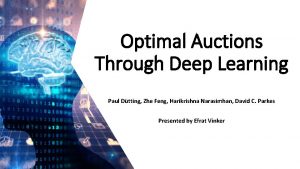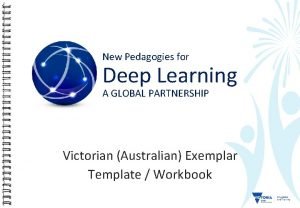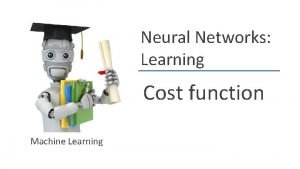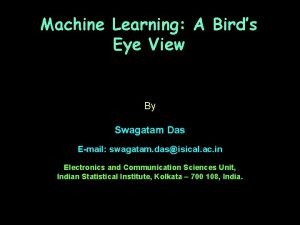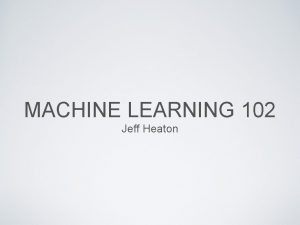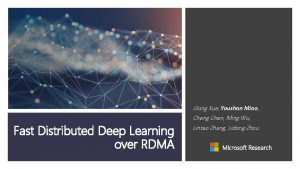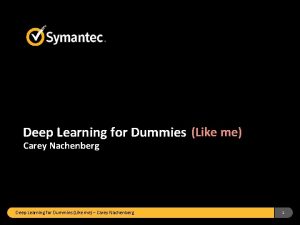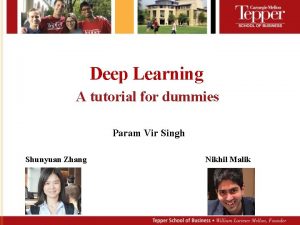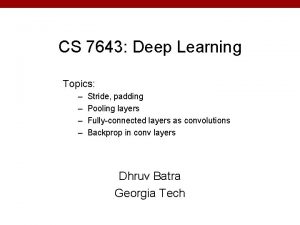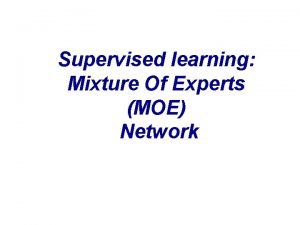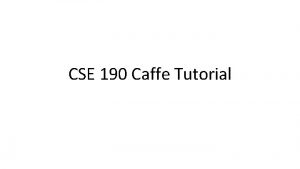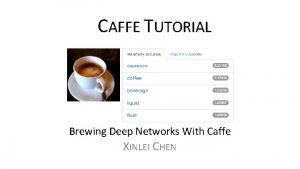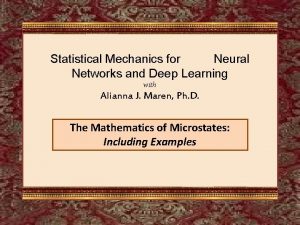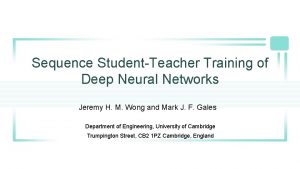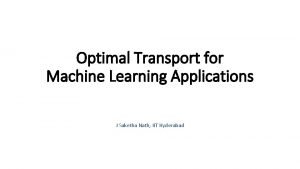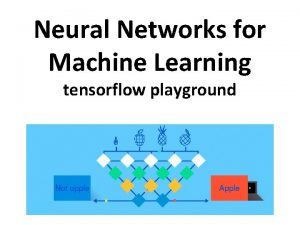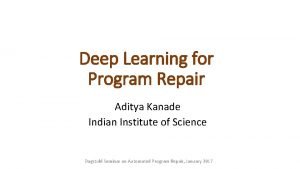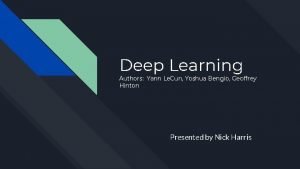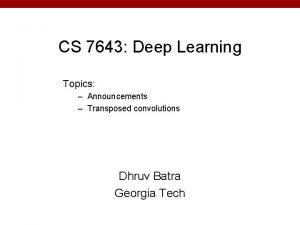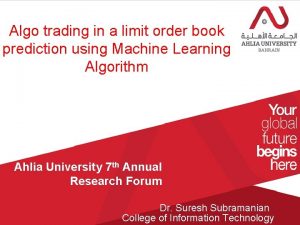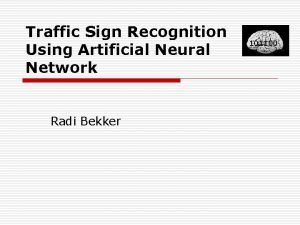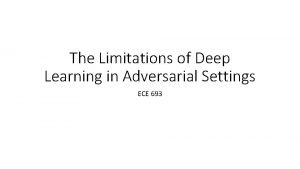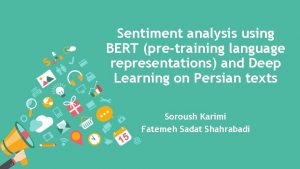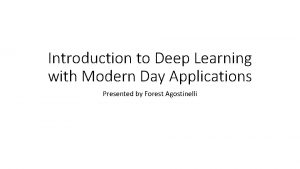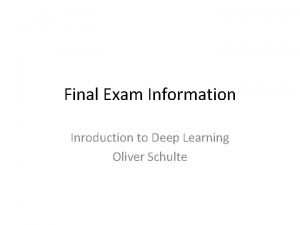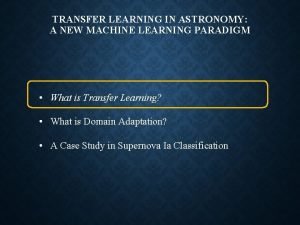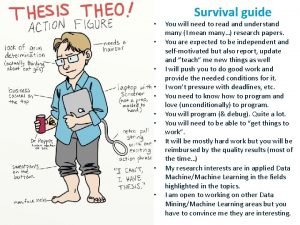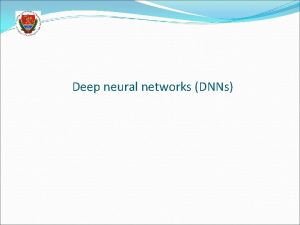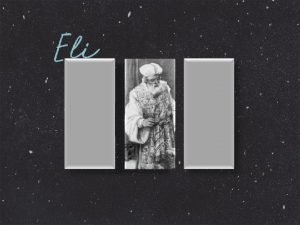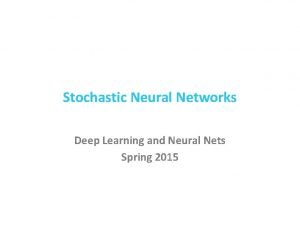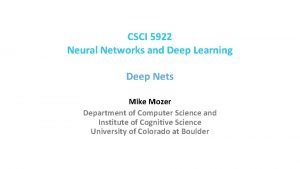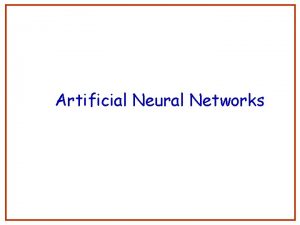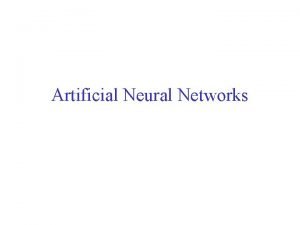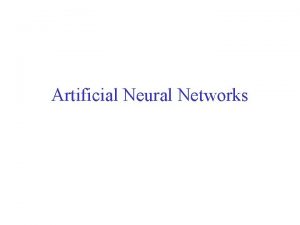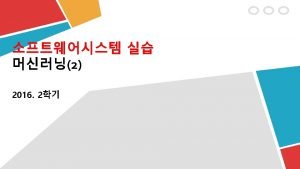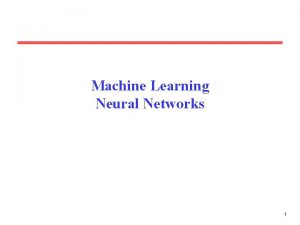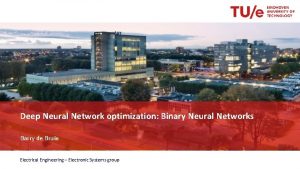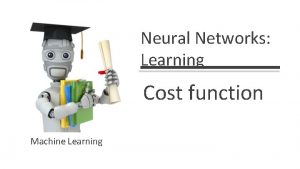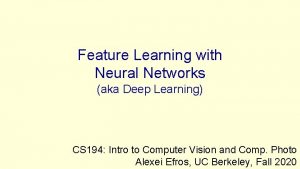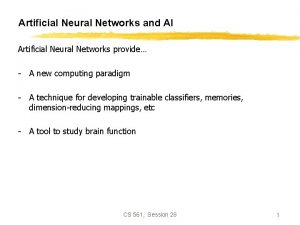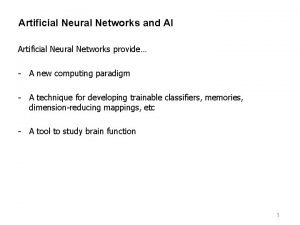Neural Networks and Deep Learning Eli Gutin MIT
























































































- Slides: 88

Neural Networks and Deep Learning Eli Gutin MIT 15. S 60 (adapted from 2016 course by Iain Dunning)

Goals today Go over basics of neural nets n Introduce Tensor. Flow n Introduce Deep Learning n Look at key applications n Practice coding in Python n Become familiar with Deep Reinforcement Learning (if time permits!) n

Plan for today 1. 2. 3. 4. Theory: Supervised learning & NNs Coding: classification problem Theory: Unsupervised learning Coding: auto-encoder Theory: Deep Learning Coding: MNIST with Conv. Nets Theory: Deep Reinforcement Learning

Supervised Learning and Neural Nets

Motivation Artificial intelligence… n Basic example: can the computer distinguish between cats and dogs? n

Supervised Learning Dog=1 Cat=0 Dog=1 Now tell me: cat or dog?

Supervised Learning n Each image is 32 x 32=1024 pixels n 3 channels: RGB n Input is a 1024*3 = 3072 dimensional space

Supervised Learning n Each image is 32 x 32=1024 pixels n 3 channels: RGB n Input is a 1024*3 = 3072 dimensional space n Ground truth function n Given training samples can we find ? if dog; else 0

Perceptron: an early attempt n n Activation function

Perceptron: an early attempt n n Activation function n Need to tune x 1 … x 2 and w 1 w 2 b 1 σ

Perceptron: an early attempt

Perceptron: an early attempt “Tune w and b so that the approximation is accurate”

Main issue with Perceptron n Ground truth may simply not be linear n Need to generalize the Perceptron idea

Multilayer perceptron 1 2 w 1 A w 1 B A w 1 C 3 We can call the box a “neuron” A neuron is of the form 1(w. x + b > 0)

Multilayer perceptron w 1 A A 1 2 w. AE w 2 B B E C 3 w 1 D We just added a neuron layer! w. DE D A neuron is of the form 1(w. x + b > 0)

Multilayer perceptron w 1 A A 1 2 w. AE w 2 B B E C 3 w 1 D We just added a neuron layer! We just introduced non-linearity! w. DE D A neuron is of the form σ(w. x + b) where σ is an activation function

Ways to choose activation function STEP FUNCTION Used in good oldfashioned perceptron

Ways to choose activation function LINEAR like linear regression (only used for final layer) LOGISTIC / SIGMOIDAL / TANH Smooth, differentiable, saturating functions RECTIFIED LINEAR (Re. LU) Cheap to compute, popular lately

Final generalization for MLP n Output can be multi-dimensional

Universal approximation theorem n n Theorem: 2 -layer NNs with sigmoid activation functions can approximate any other function (Kurt Hornik: Approximation Capabilities of Multi. Layer Feed. Forward Networks, 1991)

How do we optimize the neural net’s parameters? n Quantify how bad the current net is via loss function

How do we optimize the neural net’s parameters? Quantify how bad the current net is via loss function n Training data is. Parameters n Loss function is n ¨ E. g. square loss

How do we optimize the neural net’s parameters? Quantify how bad the current net is via loss function n Training data is. Parameters n Loss function is n ¨ E. g. n square loss Need to minimize the loss function

Backpropagation algorithm f f f winp Chain rule! nhid whid nout

Backpropagation algorithm f f f winp nhid whid nout

Notes on backpropagation n. Can calculate derivatives automatically n. Opportunities n. Re-using for parallelism intermediate values and other efficiencies n. Painful DIY - if only there was a framework. . .

Implementing Neural Nets with Tensor. Flow

Frameworks for Implementing Neural Networks

Today: Google Tensor. Flow n. Use TF to describe computations as a graph n. TF schedules computations on devices CPU, GPU. . . n. Performs automatic differentiation (like Ju. MP!) n. Python is easy to use

Project 1 - Nonlinear classification n. Goal: approximate an unknown non-linear classifier from data n. Plan: generate data, create ANN, fit it n. Live coding in IPython - follow along! n. Play with extending the code

Project 1: Non-linear classification f f Y f N SOFTMAX OUTPUT LAYER OUTPUT f f INPUT HIDDEN LAYER

Project 1: softmax layer n Generalization of logistic function Squashes a bunch of arbitrarily real numbers into a prob. distribution n Think of this as yet another activation function n

Project 1: cross-entropy loss n Since we’re comparing a prob. distribution to true 1 -hot encoding, we’ll use the cross-entropy function as the loss:

Project 1: extensions n Try changing… ¨ the number of training points ¨ the number of hidden neurons ¨ the input layer activation function ¨ Gradient Descent’s learning rate ¨ the optimization algorithm ¨ etc.

Unsupervised learning & data representation http: //www. mit. edu/~9. 520/fall 16/Classes/ldr. html

Successful ML ingredients 1. Learning algorithms 2. Lots of labeled data 3. Computational power

Successful ML ingredients 1. Learning algorithms 2. Lots of labeled(!!) data 3. Computational power

Why unsupervised? n Labeled data is expensive to get ¨ Unlabeled n data cheaper / widely available Different goals: ¨ Cluster analysis ¨ Embedding data in new vector spaces ¨ Compression… n Finding good representations can improve Supervised Learning

Why unsupervised? n Finding good representations can improve Supervised Learning

Example: autoencoders n Images are high-dimensional vectors n Hypothesis: can project high-dimensional vectors into low-dimension without much loss n PCA is a classic way of doing this n Can also use ANN!

ERROR = f(INPUT - OUTPUT) INPUT ENCODE DECODE f f f HIDDEN LAYER CODE HIDDEN LAYER OUTPUT

Project 2 – “learn” binary? n Consider “one-hot” vectors for the numbers 1 to 8 ¨ [1, 0, 0, 0, 0] [0, 1, 0, 0, 0] [0, 0, 1, 0, 0, 0] … n Can represent these vectors in 3 D, e. g. ¨ [0, 0, 0] [1, 0, 0] n [0, 0, 1] [0, 1, 0] [0, 1, 1] [1, 0, 1] [1, 1, 0] [1, 1, 1] Can a neural network learn that? Concept from: https: //blog. wtf. sg/2014/05/10/recursive-autoencoders-an-introduction/

Project 2 – “learn” binary? 1 2 ENCODER DECODER 3 . . . Concept from: https: //blog. wtf. sg/2014/05/10/recursive-autoencoders-an-introduction/

Project 2 - Assignments - Try. . . n… changing the activation functions n. . . using fewer hidden units - what can you recover? n. . . n… using multiple layers using different weight for encoding and decoding or adding biases

Recent work on representations: word 2 vec n Given a text corpus, embed words in n-dimensional space n “Similar” n Use words should be “close” in this space a (fairly simple) neural network to encode n Results are… Paper: http: //arxiv. org/pdf/1301. 3781. pdf Tensor. Flow example: https: //www. tensorflow. org/versions/master/tutorials/word 2 vec/index. html

PARIS - FRANCE + ITALY = ROME JAPAN - SUSHI + GERMANY = BRATWURST BIG - BIGGER + COLD = COLDER

https: //github. com/Newmu/dcgan_code “Unsupervised Representation Learning with Deep Convolutional Generative Adversarial Networks”

Deep Learning with Conv. Nets Based on: https: //adeshpande 3. github. io/ABeginner's-Guide-To-Understanding-Convolutional-Neural. Networks/

More info: http: //arxiv. org/abs/1409. 0575 Image. Net Classification Challenge (annual) n 1000 object classes, Approximately 1. 2 million training, 50 k validation, and 100 k test images. n Big improvements: 28. 2% error rate to 6. 7% error rate human level! How? CNNs!

Deep Learning for image processing Back to cats and dogs… n Input dimension is ~200 k (256*3)!! n Challenges: n ¨ computationally intensive ¨ questionable performance with shallow architectures… ¨. . would require astronomical amount of data

What is deep learning? n n Set of algorithms that learn data representation ¨ We focus today on Conv. Nets Learning represenation and training classifier at the same time is the novelty with Deep Learning! ¨ “It’s not that SVMs are bad”

Basic ingredients of Conv. Nets n Lots of layers. . . more usually perform better! n Most commonly used: ¨ Fully Connected Layers (MLPs - already covered today) ¨ Convolution ¨ Pooling ¨ Dropout ¨ Others: batch norm, Re. LU, etc.

Convolution INPUT MATRIX . . . FILTER OUTPUT MATRIX

Convolution Image Filter

Convolution Image Filter

Convolution – The intuition

Convolution – the intuition n Recall the curve detector Output matrix will have a large value here!

Convolution – the intuition Conversely, the output matrix will have a zero value here!

Convolution - summary n n n Different filters (each acting as a feature detector) produce a feature map Shallow layers detect low-level features Deeper layers learn more complicated features

Pooling layers in CNN, deep structures n Maybe a filter learns to detect eyes n Precise location of eye is maybe unimportant n Use a pooling layer to downsample CONVOLUTION OUTPUT 2 x 2 MAX POOLING OUTPUT

Dropout - cheap regularization for ANN http: //jmlr. org/papers/volume 15/srivastava 14 a. pdf

Early Conv. Net: “Le. Net-5” http: //deeplearning. net/tutorial/lenet. html

“Le. Net” 1998: “Alex. Net” 2012: “Goog. Le. Net” 2014: “Inception v 3” 2015: Source: http: //josephpcohen. co m/w/visualizing-cnnarchitectures-side-byside-with-mxnet/

Project 3 - MNIST Digit Recognition n. Classify hand-written images of digits 0 to 9 n. Classic “MNIST” data set used widely in ML research n. Will use convolutional neural networks!

Project 3 - Assignments - Try. . . n… changing the filter sizes, max pool size n. . . adding or removing layers n. . . using SGD n… varying the amount of dropout (with iteration? ) n… varying the batch size

Deep Reinforcement Learning

Learning to play from frames? https: //www. youtube. com/watch? v=Q 70 ul. PJW 3 Gk

Challenges of Reinforcement Learning Can we learn the right moves from frames/scores? n Need lots of accurately labeled data for ML n However, in video games we have n ¨ Sparse noisy signal ¨ Delayed observations ¨ Data is not guaranteed to be independent

Optimal game AI n How do we play (Atari) games optimally?

Optimal game AI n n How do we play (Atari) games optimally? Game is a MDP ¨ State of first t frames

Optimal game AI n n How do we play (Atari) games optimally? Game is a MDP ¨ State of first t frames ¨ Action

Optimal game AI n n How do we play (Atari) games optimally? Game is a MDP ¨ State of first t frames ¨ Action ¨ Discounted return

Optimal game AI n n How do we play (Atari) games optimally? Game is a MDP ¨ State of first t frames ¨ Action ¨ Discounted return ¨ Environment gives state transitions

Q-learning n Q function is the optimal expected return when starting in state s and playing action a

Q-learning n Q function is the optimal expected return when starting in state s and playing action a n Given Q function the optimal policy is straightforward

Q-learning n Model free way to (eventually) get Q ¨ Initialize Q to random values ¨ Initialize state

Q-learning n Model free way to (eventually) get Q ¨ Initialize Q to random values ¨ Initialize state ¨ For i = 1, 2, 3, 4, …: n Play action greedily according to Q function n Environment gives you next state s’ n Update with:

Q-learning n Model free way to (eventually) get Q ¨ Initialize Q to random values ¨ Initialize state ¨ For i = 1, 2, 3, 4, …: n Play action greedily according to Q function n Environment gives you next state s’ n Update with: n Under certain conditions

Issue with Q-learning n n In Atari games the state is last 4 frames After compression: 84 x 84 grayscale images with 256 color levels state space of size 25684*84*4 ≈ 1067970!!! we need that much memory…

How to address? n Function approximation ¨ Use ANN!

How to address? n Function approximation ¨ Use n ANN! Given samples of states and actions, find approximation by minimizing:

How to address? n Given samples of states and actions, find approximation by minimizing:

How to address? n Given samples of states and actions, find approximation by minimizing: n The targets are

The DQN algorithm n How to get some independence in the samples? n DQN uses experience replay of last 1 M frames n Samples (before, action, reward, after) tuples uniformly from that experience n Then trains the Q-network…

Deep Q-network

Deep Q-learning Paper: https: //www. cs. toronto. edu/~vmnih/docs/dqn. pdf

Deep convolution Q network n This is the architecture that Deep. Mind had in mind

Thank you!
 Deep forest: towards an alternative to deep neural networks
Deep forest: towards an alternative to deep neural networks Supervised learning
Supervised learning Deep neural networks and mixed integer linear optimization
Deep neural networks and mixed integer linear optimization Efficient processing of deep neural networks
Efficient processing of deep neural networks Least mean square algorithm in neural network
Least mean square algorithm in neural network Neural networks and learning machines
Neural networks and learning machines Eli eli lama azavtani analiza pjesme
Eli eli lama azavtani analiza pjesme Few shot learning with graph neural networks
Few shot learning with graph neural networks Gutin
Gutin Gregory gutin
Gregory gutin Tony wagner's seven survival skills
Tony wagner's seven survival skills Visualizing and understanding convolutional neural networks
Visualizing and understanding convolutional neural networks Neural networks for rf and microwave design
Neural networks for rf and microwave design Fuzzy logic lecture
Fuzzy logic lecture Deep learning vs machine learning
Deep learning vs machine learning Vc dimension of neural networks
Vc dimension of neural networks Neural network ib psychology
Neural network ib psychology Audio super resolution using neural networks
Audio super resolution using neural networks Convolutional neural networks for visual recognition
Convolutional neural networks for visual recognition Image style transfer using convolutional neural networks
Image style transfer using convolutional neural networks Convolutional neural network ppt
Convolutional neural network ppt Rnn
Rnn Neural network matlab toolbox
Neural network matlab toolbox 11-747 neural networks for nlp
11-747 neural networks for nlp Xor problem
Xor problem Sparse convolutional neural networks
Sparse convolutional neural networks On the computational efficiency of training neural networks
On the computational efficiency of training neural networks Tlu perceptron
Tlu perceptron Xooutput
Xooutput Convolutional neural networks
Convolutional neural networks Convolutional neural networks
Convolutional neural networks Neuraltools neural networks
Neuraltools neural networks Gated recurrent unit in deep learning
Gated recurrent unit in deep learning Predicting nba games using neural networks
Predicting nba games using neural networks The wake-sleep algorithm for unsupervised neural networks
The wake-sleep algorithm for unsupervised neural networks Audio super resolution
Audio super resolution Alternatives to convolutional neural networks
Alternatives to convolutional neural networks Datagram switching
Datagram switching Deep asleep deep asleep it lies
Deep asleep deep asleep it lies 深哉深哉耶穌的愛
深哉深哉耶穌的愛 Image super-resolution using deep convolutional networks
Image super-resolution using deep convolutional networks Neural language model
Neural language model Greedy layer wise training of deep networks
Greedy layer wise training of deep networks Deep convolutional networks
Deep convolutional networks Convolutional deep belief networks
Convolutional deep belief networks Basestore iptv
Basestore iptv Cuadro comparativo e-learning b-learning m-learning
Cuadro comparativo e-learning b-learning m-learning Adaptive learning neural network
Adaptive learning neural network Terminator learning computer
Terminator learning computer Autoencoders, unsupervised learning, and deep architectures
Autoencoders, unsupervised learning, and deep architectures Kubernetes vgpu
Kubernetes vgpu Operator fusion deep learning
Operator fusion deep learning Hadoop deep learning
Hadoop deep learning Gandiva: introspective cluster scheduling for deep learning
Gandiva: introspective cluster scheduling for deep learning Kaiming he
Kaiming he Deep learning speech recognition
Deep learning speech recognition Cs 7643 deep learning
Cs 7643 deep learning Machine learning
Machine learning Mitesh khapra
Mitesh khapra Father of deep learning
Father of deep learning Dtting
Dtting Deep learning competencies 6 c's
Deep learning competencies 6 c's Neural network cost function
Neural network cost function Bird eye view deep learning
Bird eye view deep learning Jeff heaton github
Jeff heaton github Jilong xue
Jilong xue Deep learning dummies
Deep learning dummies Backpropagation for dummies
Backpropagation for dummies Cs 7643 deep learning
Cs 7643 deep learning Moe deep learning
Moe deep learning Xkcd image recognition
Xkcd image recognition Intel deep learning training tool
Intel deep learning training tool Caffe framework tutorial
Caffe framework tutorial Caffe deep learning tutorial
Caffe deep learning tutorial Statistical mechanics of deep learning
Statistical mechanics of deep learning Student teacher neural network
Student teacher neural network Ioslides
Ioslides Deep learning playground
Deep learning playground Deepfix: fixing common c language errors by deep learning
Deepfix: fixing common c language errors by deep learning Deep learning yoshua bengio authors
Deep learning yoshua bengio authors Cs 7643
Cs 7643 Deep learning for limit order books
Deep learning for limit order books Traffic sign recognition deep learning
Traffic sign recognition deep learning The limitations of deep learning in adversarial settings.
The limitations of deep learning in adversarial settings. Unsupervised sentiment analysis using bert
Unsupervised sentiment analysis using bert Deep learning
Deep learning Deep learning final exam
Deep learning final exam Astronomy active learning
Astronomy active learning Deep learning captcha
Deep learning captcha

